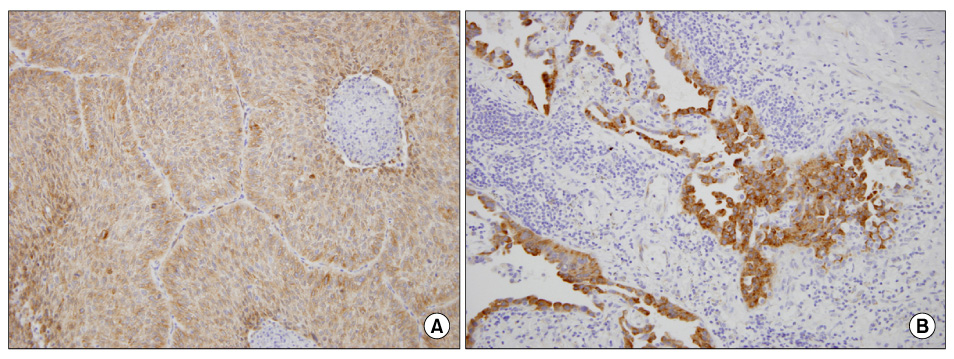Tuberc Respir Dis.
2011 Nov;71(5):349-354.
E6 Oncoprotein Expression in Non-Small Cell Lung Cancer Patients
- Affiliations
-
- 1Department of Internal Medicine, The Catholic University of Daegu School of Medicine, Daegu, Korea. hdsomn@cu.ac.kr
Abstract
- BACKGROUND
Lung cancer is the leading cause of cancer deaths in the world. Human papillomavirus (HPV) infection and E6 oncoprotein expression are known risk factors for the development of non-small cell lung cancer (NSCLC). This study was performed to evaluate the prevalence of HPV 16/18 E6 oncoprotein expression in patients with NSCLC.
METHODS
Immunohistochemical stains of the HPV 16/18 E6 oncoprotein were performed in tumor tissues from 68 patients with NSCLC who underwent curative surgery from March 2006 to November 2008.
RESULTS
The E6 oncoprotein was expressed in 29.4%of patients with NSCLC and a statistical analysis revealed that E6 oncoprotein expression was significantly higher in females (p=0.028), never smokers (p=0.045), and patients with adenocarcinoma (p=0.022) than that in other patients.
CONCLUSION
The E6 oncoprotein was expressed in 29.4% of patients with NSCLC. Further studies detecting HPV infection and E6 oncoprotein expression in never smoking patients with NSCLC are needed.
MeSH Terms
Figure
Reference
-
1. Cancer mortality rates 2009 [Internet]. National Cancer Information Center (NCIC). c2011. cited 2011 Nov 03. Goyang: NCIC;Available from: http://www.cancer.go.kr/cms/statics/mortality/index.html.2. Parkin DM, Bray F, Ferlay J, Pisani P. Global cancer statistics, 2002. CA Cancer J Clin. 2005. 55:74–108.3. Ko YC, Cheng LS, Lee CH, Huang JJ, Huang MS, Kao EL, et al. Chinese food cooking and lung cancer in women nonsmokers. Am J Epidemiol. 2000. 151:140–147.4. Chen CJ, Wu HY, Chuang YC, Chang AS, Luh KT, Chao HH, et al. Epidemiologic characteristics and multiple risk factors of lung cancer in Taiwan. Anticancer Res. 1990. 10:971–976.5. Sun S, Schiller JH, Gazdar AF. Lung cancer in never smokers--a different disease. Nat Rev Cancer. 2007. 7:778–790.6. Cheng YW, Chiou HL, Sheu GT, Hsieh LL, Chen JT, Chen CY, et al. The association of human papillomavirus 16/18 infection with lung cancer among nonsmoking Taiwanese women. Cancer Res. 2001. 61:2799–2803.7. Werness BA, Levine AJ, Howley PM. Association of human papillomavirus types 16 and 18 E6 proteins with p53. Science. 1990. 248:76–79.8. Scheffner M, Werness BA, Huibregtse JM, Levine AJ, Howley PM. The E6 oncoprotein encoded by human papillomavirus types 16 and 18 promotes the degradation of p53. Cell. 1990. 63:1129–1136.9. Cheng YW, Wu MF, Wang J, Yeh KT, Goan YG, Chiou HL, et al. Human papillomavirus 16/18 E6 oncoprotein is expressed in lung cancer and related with p53 inactivation. Cancer Res. 2007. 67:10686–10693.10. Chen YC, Chen JH, Richard K, Chen PY, Christiani DC. Lung adenocarcinoma and human papillomavirus infection. Cancer. 2004. 101:1428–1436.11. Tseng CJ, Pao CC, Lin JD, Soong YK, Hong JH, Hsueh S. Detection of human papillomavirus types 16 and 18 mRNA in peripheral blood of advanced cervical cancer patients and its association with prognosis. J Clin Oncol. 1999. 17:1391–1396.12. Walboomers JM, Jacobs MV, Manos MM, Bosch FX, Kummer JA, Shah KV, et al. Human papillomavirus is a necessary cause of invasive cervical cancer worldwide. J Pathol. 1999. 189:12–19.13. Syrjänen KJ. Condylomatous changes in neoplastic bronchial epithelium. Report of a case. Respiration. 1979. 38:299–304.14. Klein F, Amin Kotb WF, Petersen I. Incidence of human papilloma virus in lung cancer. Lung Cancer. 2009. 65:13–18.15. Skegg DC, Corwin PA, Paul C, Doll R. Importance of the male factor in cancer of the cervix. Lancet. 1982. 2:581–583.16. Okinawa Prefectural Government. Annual statistical report of health and environment 1986-1995. 1995. Okinawa: Okinawa Prefectural Government.17. Miasko A, Niklińska W, Nikliński J, Chyczewska E, Naumnik W, Chyczewski L. Detection of human papillomavirus in non-small cell lung carcinoma by polymerase chain reaction. Folia Histochem Cytobiol. 2001. 39:127–128.18. Miyagi J, Tsuhako K, Kinjo T, Iwamasa T, Hirayasu T. Recent striking changes in histological differentiation and rate of human papillomavirus infection in squamous cell carcinoma of the lung in Okinawa, a subtropical island in southern Japan. J Clin Pathol. 2000. 53:676–684.19. Kinoshita I, Dosaka-Akita H, Shindoh M, Fujino M, Akie K, Kato M, et al. Human papillomavirus type 18 DNA and E6-E7 mRNA are detected in squamous cell carcinoma and adenocarcinoma of the lung. Br J Cancer. 1995. 71:344–349.20. Ciotti M, Giuliani L, Ambrogi V, Ronci C, Benedetto A, Mineo TC, et al. Detection and expression of human papillomavirus oncogenes in non-small cell lung cancer. Oncol Rep. 2006. 16:183–189.21. Hsu NY, Cheng YW, Chan IP, Ho HC, Chen CY, Hsu CP, et al. Association between expression of human papillomavirus 16/18 E6 oncoprotein and survival in patients with stage I non-small cell lung cancer. Oncol Rep. 2009. 21:81–87.22. Gillison ML, Koch WM, Capone RB, Spafford M, Westra WH, Wu L, et al. Evidence for a causal association between human papillomavirus and a subset of head and neck cancers. J Natl Cancer Inst. 2000. 92:709–720.23. Ritchie JM, Smith EM, Summersgill KF, Hoffman HT, Wang D, Klussmann JP, et al. Human papillomavirus infection as a prognostic factor in carcinomas of the oral cavity and oropharynx. Int J Cancer. 2003. 104:336–344.24. Lindel K, Beer KT, Laissue J, Greiner RH, Aebersold DM. Human papillomavirus positive squamous cell carcinoma of the oropharynx: a radiosensitive subgroup of head and neck carcinoma. Cancer. 2001. 92:805–813.25. Weinberger PM, Yu Z, Haffty BG, Kowalski D, Harigopal M, Brandsma J, et al. Molecular classification identifies a subset of human papillomavirus--associated oropharyngeal cancers with favorable prognosis. J Clin Oncol. 2006. 24:736–747.26. Fakhry C, Gillison ML. Clinical implications of human papillomavirus in head and neck cancers. J Clin Oncol. 2006. 24:2606–2611.
- Full Text Links
- Actions
-
Cited
- CITED
-
- Close
- Share
- Similar articles
-
- Human Papillomavirus Detection and E6 Oncoprotein Expression in Uterine Cervical Cancer
- Selective expression of death receptor 4 and induction of apoptosis by HPV E6
- Comparison of cell growth suppression in SiHa cervical carcinoma cell line by human papillomavirus type 16 E6/E7 siRNAs
- Development of Trans Attack Anticancer Gene Vaccine Interact in HPV Oncoprotein Expression Inhibition
- Prognostic Value of PCNA , c-erbB-2 , c-fos in Patients with Non-small Cell Lung Cancer


